Starsky Carr
The charming and engaging Starsky Carr gave the Wellspring a glowing review on his popular Youtube channel The video features a tracking shot to die for. Thanks Starsky!
Sound on Sound
Sound on Sound is a monthly music technology magazine that has been in print since 1985. The magazine includes product tests of electronic musical performance and recording devices, and interviews with industry professionals.
We were very lucky to have a great review of the Wellspring published in the April 2024 edition, written by Neil Rogers. Some exerpts of which follow below.
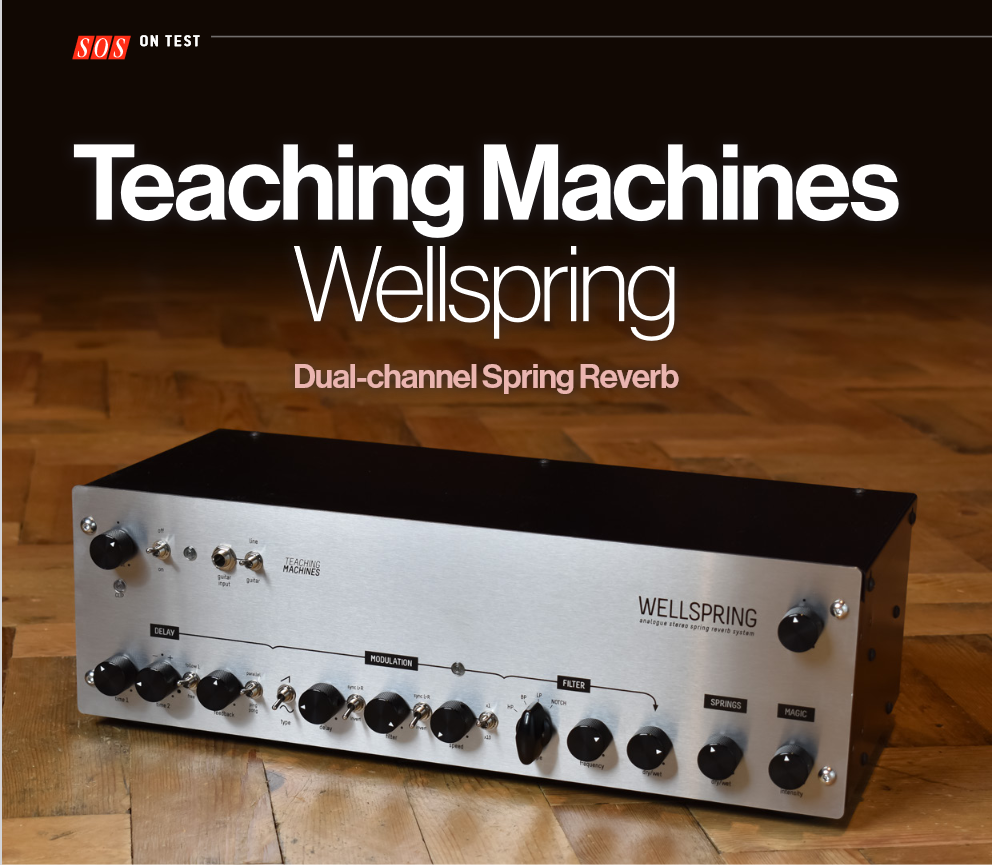
The Wellspring feeling at home on a lovely bit of parquet flooring
Snippets of the review
by Neil Rogers
The build quality seems very good to me, with all the controls feeling solid and reassuring to use…
I reckon the designers have undersold this [delay] section of the unit somewhat in their literature – it’s a great-sounding analogue delay in its own right!
The Wellspring’s EQ and filter options are powerful tools for shaping your signal before it hits the springs. As well the expected low and high-pass filter options, you can choose a band-pass filter to only allow frequencies in a certain range to pass through, or a notch filter to remove a narrow range of frequencies…
[on the ‘Magic’ control] If used subtly you can achieve an effect that’s very difficult to convey using words other than ‘magic’!
The low and high-pass filters work superbly for gently shaping the effect away from the top or bottom of your mix. I especially like filtering out much of the top end so that the reverb acts as a kind of low-level ‘thickener’ on a mix…
As I got more attuned to the ways in which the different sections interact, I found it to be more and more flexible and more and more fun…
It’s one of those bits of kit that encourages you to play and experiment not only with the effect itself but also with your instrument and playing technique…
This really is a great-sounding analogue effects unit. The springs themselves sound wonderful, and whilst you might not have a means of adjusting the length of the reverb tail directly, there’s a fantastic range of features that can help you shape the reverb to suit any source or mix. These are much more than add-ons; rather, they’re fundamental to the designer’s intention of how you should use the Wellspring, and they allow you to create dark, characterful delays and modulation-style effects to your heart’s content.
Pros
- Great-sounding stereo spring reverb.
- Filter section allows for effective shaping of the reverb tail.
- Analogue delay sounds fantastic with and without the reverb.
- Lots of creative options that will grow as you learn and experiment.
- A great ‘new’ alternative to vintage effect options.
Cons
- Takes a little while to get to grips with.
- The nature of the all-analogue design can be limiting at times.
Summary
A wonderful-sounding, all-analogue stereo spring reverb. The filter, delay and modulation sections allow for flexible shaping of the spring effect, as well as forming creative effect options in their own right.
Cheers!
Our thanks must go to Neil Rogers and Sound on Sound for this great review, you can read the whole thing here…..
Tape Op
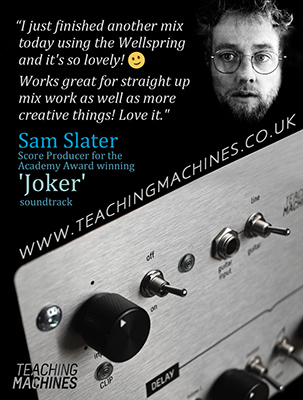
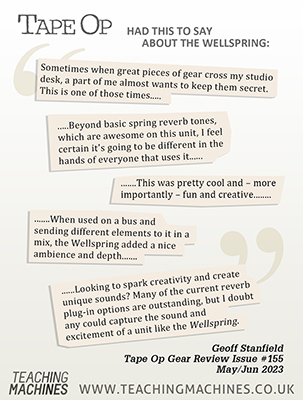
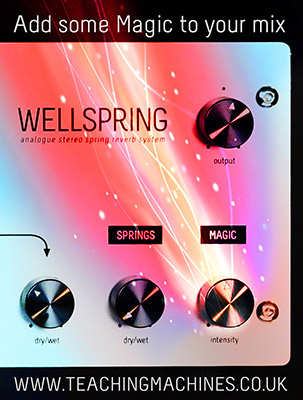
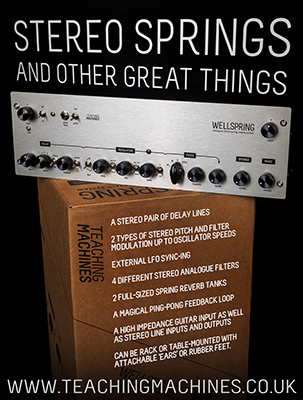
A few ads we’ve run in Tape Op magazine.
Tape Op is a highly regarded independent magazine catering to audio engineers and producers, full of high profile interviews, features on studios and producers plus gear reviews. It’s a beloved publication found on all reputable studio coffee tables.
We’re utterly delighted that they printed a really lovely review of the Wellspring In the May ’23 edition.
We’ve begun advertising in the magazine too, to make the most of the glowing review and really hammer home our important message about smooth, wide analogue reverb to working studio owners.
Teaching Machines:
Wellspring Stereo Spring Reverb
Oh, I remember… outboard gear can be fun! I am fortunate to have 31 flavors of compressors, EQs, tone-makers, and boneshakers. I even own a few studio spring reverbs, but nothing quite like the Wellspring, an “analogue stereo spring reverb system” from Wales-based Teaching Machines. With two 15-inch spring tanks, an analog delay, plus a variety of tweakable parameters, it is a reverb unique unto itself. The three rack space tall device can sit on a desktop or use rack ears for mounting (rubber feet and ears included) and has an external power supply. The Wellspring is hand-built by Teaching Machines’ co-founder and mastermind, Frank Naughton.
Everything is sturdy, and the control knobs are all metal and feel great when adjusting. The TRS 1/4-inch I/O jacks on the rear are unbalanced, but I didn’t have any trouble due to that. Frank tells us, “It’s wired with ring to ground, so should be okay with most balanced cables and +4 line level signals.” The controls from left to right can be divided into two layers. Top level has the input level knob with a clip LED below, the power switch and corresponding LED indicator, a 1/4-inch guitar or instrument input with a selector for line or guitar levels, and to the right is the output level control (center is unity gain). Bottom level, broken into three sections, are Delay, Modulation, and Filter. Delay: A time 1 knob controls delay time for the left or mono signal, time 2 controls the right, and they can be synced via a switch. Feedback, as is typical, controls the number of repeats in switchable parallel or ping-pong modes. Modulation: A switch selects between Sine or Sawtooth modulation, the delay knob sets the amount of pitch modulation desired, plus there’s a switch to have L/R channels modulate in sync or out of phase with each other. The filter knob controls the filter modulation and can also be synced L/R or out of phase. The speed knob controls the speed of all internal modulation, with an x10 switch to get into some wild ring-modulation sorta effects, plus a yellow LED representing modulation speed. An external +/- 5V external modulation source can feed the 1/8-inch input jack on the back panel of the Wellspring. Filter: Select via a rotating switch High-Pass, Band-Pass, Low-Pass, or Notch; the frequency knob sets the Hz; and lastly there is a wet/dry control for this section that mixes the filtered, modulated, and delayed signal back with the dry signal before it goes to the Springs and Magic section.
Springs has one knob for dry/wet balance and Magic has a knob that controls the amount of the Springs that are sent back to the Delay section, wired so that the right spring is sent to the left channel of delay and vice-versa. One can create some wild sounds with this control, and I found I did not even need to have any input happening to make sounds appear! I did a couple performances of atmospheric ambience by having a guitar plugged in, playing a few notes to get the machine humming, and then tweaking Magic’s intensity knob to let it loose or reign it in. This was pretty cool and – more importantly – fun and creative. Given the way this reverb/delay is set up, it becomes obvious that every control on the Wellspring interacts with each other in interesting ways. With all the controls available, it seems there is an endless array of sounds and treatments that are available. Take some time to learn it, plus check out their website for ideas. Beyond basic spring reverb tones, which are awesome on this unit, I feel certain it’s going to be different in the hands of everyone that uses it.
I like the benefit of a guitar input right on the front of the unit and it was great for recording direct, with a good tone and very usable for certain applications. It even had a pleasing distortion when I drove the input hard. It’s quite usable and certainly great for an alternative tone when needed. I was able to get surfy swells, wildly-modulated chaos, beautiful Pink Floyd/David Gilmour-like tones, and Radiohead-style dreamy wetness.
When used on a bus and sending different elements to it in a mix, the Wellspring added a nice ambience and depth. Some of the Modulation section I initially felt was simply more than I needed (or was able to wrap my head around?), but as time went on I liked being able to subtly modulate the reverb tails for some interesting sounds. Gentle usage of this section was my instinct, but it’s easy to go for something crazy, and at times it even sounded like there were keyboard or synth pads playing in the background. There’s so much to experiment with here!
Sometimes when great pieces of gear cross my studio desk, a part of me almost wants to keep them secret. This is one of those times. Looking to spark creativity and create unique sounds? Many of the current reverb plug-in options are outstanding, but I doubt any could capture the sound and excitement of a unit like the Wellspring.
Reviewed by Geoff Stanfield
Youtube
Rhodes
We’ve also just started posting a few mini demos of the wellspring on our YouTube Channel, this one features a Rhodes Mark II Stage 73 electric piano plugged directly into the mono input of the Wellspring. Honestly it sounds great!
Thanks Jess
This one features vocals, recorded as BV’s for a collaborative project, again fed directly into the Wellspring in stereo this time.
Hark, a harp!
Some beautifully played harp samples fed through the Wellspring to create a heavenly mood.
Bass thrumming
Some simple electric bass chords fed through the Wellspring.
Bamboo Flute
Some badly played bamboo flute fed through the Wellspring to create a sense of forest calm.
More mini demos on our YouTube channel and more being added all the time.



